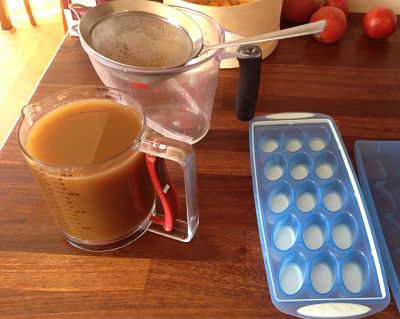 I’ve written a lot about making stock and even included a basic recipe, but as many of you are wondering what to do with that turkey carcass taking up a good chunk of a shelf in your refrigerator, it seemed like a good time to recap some tips for turning it into cook’s gold. This is really how I think of good stock, because it adds a depth of flavor to soups, stews, and sauces that you can’t get otherwise.
I’ve written a lot about making stock and even included a basic recipe, but as many of you are wondering what to do with that turkey carcass taking up a good chunk of a shelf in your refrigerator, it seemed like a good time to recap some tips for turning it into cook’s gold. This is really how I think of good stock, because it adds a depth of flavor to soups, stews, and sauces that you can’t get otherwise.
If you want a light stock, just break up the carcass and miscellaneous bones and cover them in water in a good size pot. (If you like a darker flavor, roast the carcass in the oven first to brown it.) Add a couple of tablespoons of vinegar to the water leach the calcium from the bones into the stock. Bring it to a boil, and immediately turn it to the lowest simmer. I simmer for hours, because I want the bones to get soft enough to grind up for the chickens, but I’d say a three hour minimum, no maximum on the simmering.
While it’s simmering, you can add things like onion skins (turns the color darker), vegetable peelings, ends of celery. But after you’ve cooked all the substance out of the carcass, strain out the meat and bones, and then add a good amount of carrots, celery, onions, garlic, herbs. You can add these all in the roughest form–no peeling, minimal chopping. (Again, you can roast these first for a more caramelized flavor in the stock.) Simmer another couple of hours and strain again. Adding a few egg shells to the pot clarifies the stock, and not pressing down on the strainer helps keep it clear. This is just for looks–cloudiness doesn’t affect the taste.
 After you’ve strained out the vegetables, there will probably be a layer of fat on top of your stock that you don’t want. You can put it in the refrigerator; the fat conceals, making it easy to peel off the now gelatinous stock. Or you can invest in a wonderful fat separator, a four-cup container with a hole in the bottom that opens when you press a lever in the handle. Let your stock sit for 10 minutes or so in the container so the fat rises to the top, then you can open the hole and “decant” the stock down to the fat level, discarding the top bit.
After you’ve strained out the vegetables, there will probably be a layer of fat on top of your stock that you don’t want. You can put it in the refrigerator; the fat conceals, making it easy to peel off the now gelatinous stock. Or you can invest in a wonderful fat separator, a four-cup container with a hole in the bottom that opens when you press a lever in the handle. Let your stock sit for 10 minutes or so in the container so the fat rises to the top, then you can open the hole and “decant” the stock down to the fat level, discarding the top bit.
If you’re going to freeze the stock, simmer it more to concentrate it. Then strain it once with a fine mesh strainer, and pour it into ice cube trays.
 I like the ones by Orka, that have flexible bottoms (easy to pop the cubes out) and covers. Once the stock is frozen,you can pop the cubes into a plastic bag, and use as needed.
I like the ones by Orka, that have flexible bottoms (easy to pop the cubes out) and covers. Once the stock is frozen,you can pop the cubes into a plastic bag, and use as needed.
There’s really no wrong way to make stock–I often just keep a pot on the back of the stove, mixing bones from various meats, and adding miscellaneous things as I cook. Here in our cool temperatures, it’s no problem to leave the stock overnight, then reheat. This can go on for awhile! A little fennel? Sure. Just be careful on the brassicas: cabbage/broccoli/cauliflower. Their flavor can overwhelm your stock. Happy leftovers!